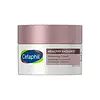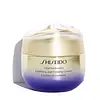What's inside
What's inside
 Key Ingredients
Key Ingredients

 Benefits
Benefits

 Concerns
Concerns

 Ingredients Side-by-side
Ingredients Side-by-side

Water
Skin ConditioningGlycerin
HumectantPropanediol
SolventDimethicone
EmollientTricaprylin
MaskingMyristyl Myristate
EmollientCetyl Alcohol
EmollientNiacinamide
SmoothingGlyceryl Stearate Se
EmulsifyingPEG-100 Stearate
C12-15 Alkyl Benzoate
AntimicrobialBakuchiol
AntimicrobialSilica
AbrasivePhenoxyethanol
PreservativePentaerythrityl Tetraethylhexanoate
EmollientAmmonium Acryloyldimethyltaurate/Vp Copolymer
Behenyl Alcohol
EmollientPhytosteryl/Octyldodecyl Lauroyl Glutamate
Skin ConditioningSorbitan Tristearate
EmulsifyingIsostearic Acid
CleansingStearyl Alcohol
EmollientAlcohol
AntimicrobialEthylhexylglycerin
Skin ConditioningPhenylethyl Resorcinol
AntioxidantDisodium EDTA
Malva Sylvestris Flower/Leaf/Stem Extract
Skin ConditioningMentha Piperita Leaf Extract
Skin ConditioningPrimula Veris Flower Extract
Skin ConditioningAlchemilla Vulgaris Flower/Leaf/Stem Extract
AstringentVeronica Officinalis Flower/Leaf/Stem Extract
AstringentMelissa Officinalis Leaf Extract
Skin ConditioningAchillea Millefolium Flower/Leaf/Stem Extract
Skin ConditioningCitric Acid
BufferingSodium Hyaluronate
HumectantSodium Hydroxide
BufferingWater, Glycerin, Propanediol, Dimethicone, Tricaprylin, Myristyl Myristate, Cetyl Alcohol, Niacinamide, Glyceryl Stearate Se, PEG-100 Stearate, C12-15 Alkyl Benzoate, Bakuchiol, Silica, Phenoxyethanol, Pentaerythrityl Tetraethylhexanoate, Ammonium Acryloyldimethyltaurate/Vp Copolymer, Behenyl Alcohol, Phytosteryl/Octyldodecyl Lauroyl Glutamate, Sorbitan Tristearate, Isostearic Acid, Stearyl Alcohol, Alcohol, Ethylhexylglycerin, Phenylethyl Resorcinol, Disodium EDTA, Malva Sylvestris Flower/Leaf/Stem Extract, Mentha Piperita Leaf Extract, Primula Veris Flower Extract, Alchemilla Vulgaris Flower/Leaf/Stem Extract, Veronica Officinalis Flower/Leaf/Stem Extract, Melissa Officinalis Leaf Extract, Achillea Millefolium Flower/Leaf/Stem Extract, Citric Acid, Sodium Hyaluronate, Sodium Hydroxide
Water
Skin ConditioningButylene Glycol
HumectantDimethicone
EmollientGlycerin
HumectantAlcohol Denat.
AntimicrobialPPG-3 Dipivalate
Skin ConditioningGlyceryl Stearate Se
EmulsifyingCetyl Alcohol
EmollientPentaerythrityl Tetraethylhexanoate
EmollientHydrogenated Polydecene
EmollientMyristyl Myristate
EmollientPEG-100 Stearate
Silica
AbrasiveBis-Diglyceryl Polyacyladipate-2
EmollientPotassium Methoxysalicylate
BleachingBehenyl Alcohol
EmollientSodium Acrylate/Sodium Acryloyldimethyl Taurate Copolymer
Emulsion StabilisingStearyl Alcohol
EmollientPolyvinyl Alcohol
Phenoxyethanol
PreservativeIsohexadecane
EmollientParfum
MaskingPolysorbate 80
EmulsifyingSorbitan Tristearate
EmulsifyingTrisodium EDTA
Erythritol
HumectantPEG/PPG-14/7 Dimethyl Ether
Skin ConditioningPEG/PPG-17/4 Dimethyl Ether
Skin ConditioningTocopheryl Acetate
AntioxidantRosa Damascena Flower Water
MaskingSodium Citrate
BufferingSuccinoglycan
Skin ConditioningAlcohol
AntimicrobialSorbitan Oleate
EmulsifyingCaffeine
Skin ConditioningCitric Acid
BufferingSodium Metaphosphate
BufferingLavandula Angustifolia Oil
MaskingPhytosteryl/Octyldodecyl Lauroyl Glutamate
Skin ConditioningLimonene
PerfumingHexyl Cinnamal
PerfumingTocopherol
AntioxidantLinalool
PerfumingCitronellol
PerfumingSodium Metabisulfite
AntioxidantCI 77492
Cosmetic ColorantAngelica Acutiloba Root Extract
Skin ConditioningAngelica Keiskei Leaf/Stem Extract
Skin ConditioningOlea Europaea Leaf Extract
PerfumingLamium Album Flower/Leaf/Stem Extract
Skin ConditioningCellulose
AbsorbentCamellia Sinensis Leaf Extract
AntimicrobialInositol
HumectantCarthamus Tinctorius Flower Extract
Skin ConditioningCI 77491
Cosmetic ColorantZiziphus Jujuba Fruit Extract
Skin ConditioningRosmarinus Officinalis Leaf Extract
AntimicrobialHydrolyzed Silk
HumectantBupleurum Falcatum Root Extract
Skin ConditioningWater, Butylene Glycol, Dimethicone, Glycerin, Alcohol Denat., PPG-3 Dipivalate, Glyceryl Stearate Se, Cetyl Alcohol, Pentaerythrityl Tetraethylhexanoate, Hydrogenated Polydecene, Myristyl Myristate, PEG-100 Stearate, Silica, Bis-Diglyceryl Polyacyladipate-2, Potassium Methoxysalicylate, Behenyl Alcohol, Sodium Acrylate/Sodium Acryloyldimethyl Taurate Copolymer, Stearyl Alcohol, Polyvinyl Alcohol, Phenoxyethanol, Isohexadecane, Parfum, Polysorbate 80, Sorbitan Tristearate, Trisodium EDTA, Erythritol, PEG/PPG-14/7 Dimethyl Ether, PEG/PPG-17/4 Dimethyl Ether, Tocopheryl Acetate, Rosa Damascena Flower Water, Sodium Citrate, Succinoglycan, Alcohol, Sorbitan Oleate, Caffeine, Citric Acid, Sodium Metaphosphate, Lavandula Angustifolia Oil, Phytosteryl/Octyldodecyl Lauroyl Glutamate, Limonene, Hexyl Cinnamal, Tocopherol, Linalool, Citronellol, Sodium Metabisulfite, CI 77492, Angelica Acutiloba Root Extract, Angelica Keiskei Leaf/Stem Extract, Olea Europaea Leaf Extract, Lamium Album Flower/Leaf/Stem Extract, Cellulose, Camellia Sinensis Leaf Extract, Inositol, Carthamus Tinctorius Flower Extract, CI 77491, Ziziphus Jujuba Fruit Extract, Rosmarinus Officinalis Leaf Extract, Hydrolyzed Silk, Bupleurum Falcatum Root Extract
Ingredients Explained
These ingredients are found in both products.
Ingredients higher up in an ingredient list are typically present in a larger amount.
Alcohol comes in many different forms. Different types of alcohol will have different effects on skin. This ingredient is usually an astringent alcohol.
These alcohols are drying on the skin. They may strip away your skin's natural oils and even damage your skin barrier. Astringent alcohols may also irritate skin.
Other types of astringent alcohols include:
According to the National Rosacea Society based in the US, you should be mindful of products with these alcohols in the top half of ingredients.
Any type of sanitizing product will have high amounts of alcohol to help kill bacteria and viruses.
Fatty alcohols come from plant oils such as coconut oil. These can help hydrate the skin and are non-irritating. Some fatty alcohols include cetyl and stearyl alcohol.
Learn more about AlcoholBehenyl Alcohol is a type of fatty alcohol (these are different from the drying, solvent alcohols).
Fatty Alcohols have hydrating properties and are most often used as an emollient or to thicken a product. They are usually derived from natural fats and oils; behenyl alcohol is derived from the fats of vegetable oils.
Emollients help keep your skin soft and hydrated by creating a film that traps moisture in.
In 2000, Behenyl Alcohol was approved by the US as medicine to reduce the duration of cold sores.
Learn more about Behenyl AlcoholCetyl Alcohol is a fatty alcohol. Fatty Alcohols are most often used as an emollient or to thicken a product.
Its main roles are:
Though it has "alcohol" in the name, it is not related to denatured alcohol or ethyl alcohol.
The FDA allows products labeled "alcohol-free" to have fatty alcohols.
Learn more about Cetyl AlcoholCitric Acid is an alpha hydroxy acid (AHA) naturally found in citrus fruits like oranges, lemons, and limes.
Like other AHAs, citric acid can exfoliate skin by breaking down the bonds that hold dead skin cells together. This helps reveal smoother and brighter skin underneath.
However, this exfoliating effect only happens at high concentrations (20%) which can be hard to find in cosmetic products.
Due to this, citric acid is usually included in small amounts as a pH adjuster. This helps keep products slightly more acidic and compatible with skin's natural pH.
In skincare formulas, citric acid can:
While it can provide some skin benefits, research shows lactic acid and glycolic acid are generally more effective and less irritating exfoliants.
Most citric acid used in skincare today is made by fermenting sugars (usually from molasses). This synthetic version is identical to the natural citrus form but easier to stabilize and use in formulations.
Read more about some other popular AHA's here:
Learn more about Citric AcidDimethicone is a type of synthetic silicone created from natural materials such as quartz.
What it does:
Dimethicone comes in different viscosities:
Depending on the viscosity, dimethicone has different properties.
Ingredients lists don't always show which type is used, so we recommend reaching out to the brand if you have questions about the viscosity.
This ingredient is unlikely to cause irritation because it does not get absorbed into skin. However, people with silicone allergies should be careful about using this ingredient.
Note: Dimethicone may contribute to pilling. This is because it is not oil or water soluble, so pilling may occur when layered with products. When mixed with heavy oils in a formula, the outcome is also quite greasy.
Learn more about DimethiconeGlycerin is already naturally found in your skin. It helps moisturize and protect your skin.
A study from 2016 found glycerin to be more effective as a humectant than AHAs and hyaluronic acid.
As a humectant, it helps the skin stay hydrated by pulling moisture to your skin. The low molecular weight of glycerin allows it to pull moisture into the deeper layers of your skin.
Hydrated skin improves your skin barrier; Your skin barrier helps protect against irritants and bacteria.
Glycerin has also been found to have antimicrobial and antiviral properties. Due to these properties, glycerin is often used in wound and burn treatments.
In cosmetics, glycerin is usually derived from plants such as soybean or palm. However, it can also be sourced from animals, such as tallow or animal fat.
This ingredient is organic, colorless, odorless, and non-toxic.
Glycerin is the name for this ingredient in American English. British English uses Glycerol/Glycerine.
Learn more about GlycerinGlyceryl Stearate Se is a self-emulsifying (SE) form of glyceryl stearate. Self-emusifying means this ingredient automatically blends with water. It is an emulsifier, emollient, and cleansing agent.
As an emulsifier, Glyceryl Stearate Se prevents ingredients such as oil and water from separating. It is also a surfactant, meaning it helps cleanse the skin. Surfactants help gather oil, dirt, and other pollutants so they may be rinsed away easily.
Emollients help your skin stay smooth and soft. It does so by creating a film on top of the skin that helps trap moisture in.
Learn more about Glyceryl Stearate SeMyristyl Myristate is created from the fatty acids of myristyl alcohol and myristic acid. In skincare, it is an emollient and texture enhancer.
On its own, this ingredient has a comedogenicity index of 5/5. This means it has the potential to clog pores. When diluted with cetyl alcohol or propylene glycol, the comedogenicity will decrease.
This ingredient may not be Malassezia folliculitis, or fungal-acne safe.
Nutmeg, palm kernel oil, and coconut oil all contain this ingredient naturally.
Learn more about Myristyl MyristatePeg-100 Stearate is an emollient and emulsifier. As an emollient, it helps keep skin soft by trapping moisture in. On the other hand, emulsifiers help prevent oil and water from separating in a product.
PEGS are a hydrophilic polyether compound . There are 100 ethylene oxide monomers in Peg-100 Stearate. Peg-100 Stearate is polyethylene glycol ester of stearic acid.
Pentaerythrityl Tetraethylhexanoate is an emollient that helps make your skin smooth and hydrated. It specializes in creating a non-oily and "wet" feeling on skin.
This ingredient comes from isostearic acid, a saturated fatty acid. It is a synthetic ingredient.
Phenoxyethanol is a preservative that has germicide, antimicrobial, and aromatic properties. Studies show that phenoxyethanol can prevent microbial growth. By itself, it has a scent that is similar to that of a rose.
It's often used in formulations along with Caprylyl Glycol to preserve the shelf life of products.
We don't have a description for Phytosteryl/Octyldodecyl Lauroyl Glutamate yet.
Silica, also known as silicon dioxide, is a naturally occurring mineral. It is used as a fine, spherical, and porous powder in cosmetics.
Though it has exfoliant properties, the function of silica varies depending on the product.
The unique structure of silica enhances the spreadability and adds smoothness, making it a great texture enhancer.
It is also used as an active carrier, emulsifier, and mattifier due to its ability to absorb excess oil.
In some products, tiny microneedles called spicules are made from silica or hydrolyzed sponge. When you rub them in, they lightly polish away dead skin layers and enhance the penetration of active ingredients.
Learn more about SilicaWe don't have a description for Sorbitan Tristearate yet.
Stearyl Alcohol is a type of fatty alcohol from stearic acid. It is a white, waxy compound used to emulsify ingredients.
Fatty Alcohols are most often used as an emollient or to thicken a product. Emollients help soothe and hydrate the skin by trapping moisture.
They are usually derived from natural fats and oils and therefore do not have the same drying or irritating effect as solvent alcohols. FDA allows products labeled "alcohol-free" to have fatty alcohols.
Learn more about Stearyl AlcoholWater. It's the most common cosmetic ingredient of all. You'll usually see it at the top of ingredient lists, meaning that it makes up the largest part of the product.
So why is it so popular? Water most often acts as a solvent - this means that it helps dissolve other ingredients into the formulation.
You'll also recognize water as that liquid we all need to stay alive. If you see this, drink a glass of water. Stay hydrated!
Learn more about Water